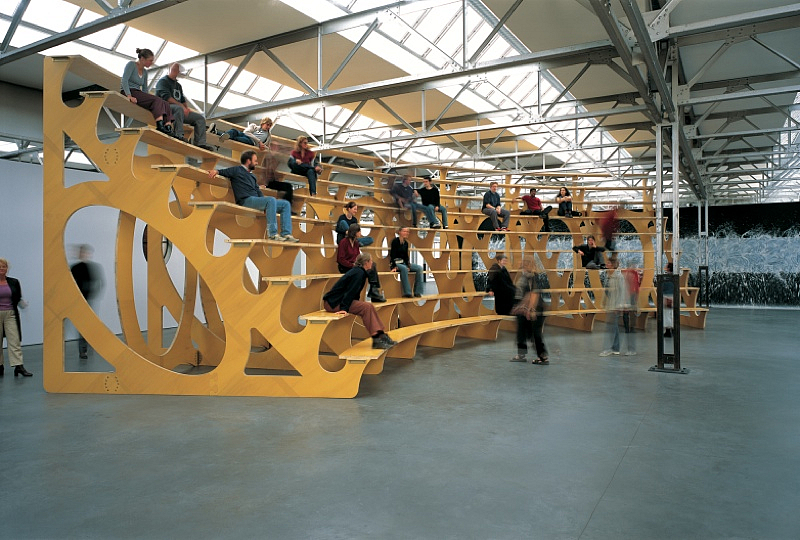In 1997 the work Arena by American artist Rita McBride (Des Moines, Iowa, 1960) was shown at Witte de With, center for contemporary art, in Rotterdam. Arena consists of semicircular segments of bleachers which, for that presentation, were set up in four different rooms. As a gigantic curve, Arena thus cut across the entire floor of the exhibition space. After having been shown in various other forms abroad, Arena is now to be part of a large exhibition of Rita McBride’s work at De Pont. The exhibition 472 New Positions will also travel to the Kunstmuseum Liechtenstein. A catalogue containing an essay by Dominic van den Boogerd will accompany the exhibition.
In his essay Van den Boogerd analyzes the work of McBride in terms of the sculptural tradition and particularly in terms of her work’s relationship to Minimal Art from the sixties and seventies. Minimal Art is characterized by the repetition of geometric forms and volumes and by the absence of a personal ‘signature’ in the treatment of material or the production of the sculpture. In scale and proportion, Minimal Art always appears in a direct relationship with the surrounding space. At the same time, the context of the museum serves as an integral part and, in a certain sense, also as a legitimization for the metal plates, wooden beams, concrete blocks and other material manifestations of Minimal Art. These are the aspects on which Rita McBride reflects in her work. Her images frequently have the appearance of abstract geometric forms, but on further consideration, the forms often prove to be taken from architecture or from industrial products. McBride deals with the problematics of this visual relationship by giving her sculptures an unexpected ambiguity in the material, size or title. The bleachers that make up Arena, for instance, are actually too big and too high for the space in which they are standing. This gives the sculpture an alienating sense of functionality. Van den Boogerd writes: “...Arena directs one’s focus to that which goes on behind, beyond or around the exhibition.
In his essay Van den Boogerd analyzes the work of McBride in terms of the sculptural tradition and particularly in terms of her work’s relationship to Minimal Art from the sixties and seventies. Minimal Art is characterized by the repetition of geometric forms and volumes and by the absence of a personal ‘signature’ in the treatment of material or the production of the sculpture. In scale and proportion, Minimal Art always appears in a direct relationship with the surrounding space. At the same time, the context of the museum serves as an integral part and, in a certain sense, also as a legitimization for the metal plates, wooden beams, concrete blocks and other material manifestations of Minimal Art. These are the aspects on which Rita McBride reflects in her work. Her images frequently have the appearance of abstract geometric forms, but on further consideration, the forms often prove to be taken from architecture or from industrial products. McBride deals with the problematics of this visual relationship by giving her sculptures an unexpected ambiguity in the material, size or title. The bleachers that make up Arena, for instance, are actually too big and too high for the space in which they are standing. This gives the sculpture an alienating sense of functionality. Van den Boogerd writes: “...Arena directs one’s focus to that which goes on behind, beyond or around the exhibition.
